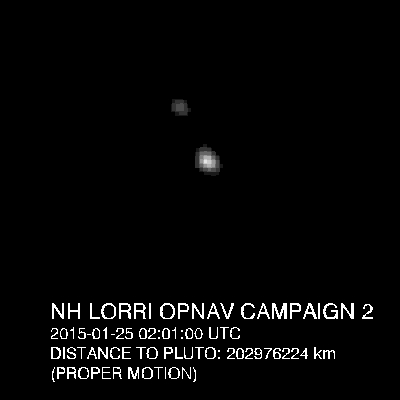
NASA / Johns Hopkins University Applied Physics Laboratory / Southwest Research Institute
The View from New Horizons: A Full Day on Pluto-Charon (Press Release)
This time-lapse “movie” of Pluto and its largest moon, Charon, was recently shot at record-setting distances with the Long-Range Reconnaissance Imager (LORRI) on NASA’s New Horizons spacecraft. The movie was made over about a week, from Jan. 25-31, 2015. It was taken as part of the mission’s second optical navigation (“OpNav”) campaign to better refine the locations of Pluto and Charon in preparation for the spacecraft’s close encounter with the small planet and its five moons on July 14, 2015.
Pluto and Charon were observed for an entire rotation of each body; a “day” on Pluto and Charon is 6.4 Earth days. The first of the images was taken when New Horizons was about 3 billion miles from Earth, but just 126 million miles (203 million kilometers) from Pluto – about 30% farther than Earth’s distance from the Sun. The last frame came 6½ days later, with New Horizons more than 5 million miles (8 million kilometers) closer.
The wobble easily visible in Pluto’s motion, as Charon orbits, is due to the gravity of Charon, which is about one-eighth as massive as Pluto and about the size of Texas.
Faint stars can be seen in background of these images. Each frame had an exposure time of one-tenth of a second, too short to see Pluto’s smaller, much fainter moons. New Horizons is still too far from Pluto and its moons to resolve surface features.

NASA / Johns Hopkins University Applied Physics Laboratory / Southwest Research Institute
The Pluto-Charon Dance: This close up look at Pluto and Charon, taken as part of the mission’s latest optical navigation (“OpNav”) campaign from Jan. 25-31, 2015, comes from the Long Range Reconnaissance Imager (LORRI) on NASA's New Horizons spacecraft.
The time-lapse frames in this movie were magnified four times to make it easier to see Pluto and Charon orbit around their barycenter, a mutual point above Pluto’s surface where Pluto and Charon’s gravity cancels out – this is why Pluto appears to “wobble” in space. Charon orbits approximately 11,200 miles (about 18,000 kilometers) above Pluto’s surface.
Each frame had an exposure time of one-tenth of a second, too short to see Pluto’s smaller, much fainter moons.
"These images allow the New Horizons navigators to refine the positions of Pluto and Charon, and they have the additional benefit of allowing the mission scientists to study the variations in brightness of Pluto and Charon as they rotate, providing a preview of what to expect during the close encounter in July," says Alan Stern, the New Horizons principal investigator from the Southwest Research Institute in Boulder, Colorado.
The Johns Hopkins University Applied Physics Laboratory manages the New Horizons mission for NASA's Science Mission Directorate in Washington. Alan Stern, of the Southwest Research Institute (SwRI), headquartered in San Antonio, is the principal investigator and leads the mission. SwRI leads the science team, payload operations, and encounter science planning. New Horizons is part of the New Frontiers Program managed by NASA's Marshall Space Flight Center in Huntsville, Alabama. APL designed, built and operates the spacecraft.
Source: New Horizons Website

No comments:
Post a Comment